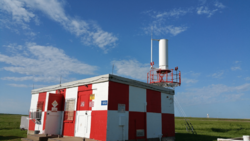Engineering:Tactical air navigation system
A tactical air navigation system, commonly referred to by the acronym TACAN, is a navigation system used by military aircraft. It provides the user with bearing and distance (slant-range or hypotenuse) to a ground or ship-borne station. It is from an end-user perspective a more accurate version of the VOR/DME system that provides bearing and range information for civil aviation. The DME portion of the TACAN system is available for civil use; at VORTAC facilities where a VOR is combined with a TACAN, civil aircraft can receive VOR/DME readings. Aircraft equipped with TACAN avionics can use this system for enroute navigation as well as non-precision approaches to landing fields.
The typical TACAN onboard user panel has control switches for setting the channel (corresponding to the desired surface station's assigned frequency), the operation mode for either transmit/receive (T/R, to get both bearing and range) or receive only (REC, to get bearing but not range). Capability was later upgraded to include an air-to-air mode (A/A), where two airborne users can get relative slant-range and/or bearing information depending on specific installations,[1] though an air-to-air bearing is noticeably less precise than a ground-to-air bearing. A TACAN only equipped aircraft cannot receive bearing information from a VOR-only station.
History
The TACAN navigation system is an evolution of radio transponder navigation systems that date back to the British Oboe system of World War II. In the United States, many companies were involved with the development of TACAN for military aircraft. Hoffman Laboratories Div. of the Hoffman Electronics Corp.–Military Products Division[2] (now NavCom Defense Electronics)[3] was a leader in developing the present TACAN system in the US starting in the late 1950s.
Operation
TACAN in general can be described as the military version of the VOR/DME system, though despite providing similar information as its civilian counterpart, its method of operation is significantly different. It operates in the UHF frequency band 962-1213 MHz, utilizing a pulse-pair transponder system not dissimilar to that of secondary surveillance RADAR. Interrogating aircraft transmit in the 1024-1150 MHz band, split into 1 MHz channels numbered 1-126; the responding station (ground, ship, or another aircraft) is 63 MHz (63 channels) above or below the originating frequency, depending on the channel and mode of operation selected. Spacing between pulses in an individual pulse-pair is also determined by TACAN operating mode.
Ranging
Range information is functionally identical to the method provided by civilian DME: transponder pulse-pairs from an aircraft are repeated by the station being interrogated, using the round-trip time to calculate slant-range distance. Randomized spacing between interrogation pulse-pairs allows the interrogator to separate its own signal from that of other aircraft, enabling multiple users to access the ranging function without mutual interference. A fixed-round trip delay time (dependent on system mode) is added to each pulse-pair when being retransmitted by its station. The interrogator will generate up to 150 pulse-pairs per second when first acquiring a station in range in "search" mode, then drop down to ≈30 per second when acquired in "track" mode.
Bearing
Bearing information is derived from amplitude modulation (AM) of the responding station's pulse-pair signals, the AM signal being generated via physical rotation of a station's directional antenna or electronic steering of the same signal using an antenna array. Two AM signals are generated: a fundamental AM signal at 15 Hz, and an auxiliary AM signal (implemented using fixed signal reflectors in rotating-antenna installations) at 135 Hz, the ninth harmonic of the fundamental signal. These correspond to a "coarse" and "fine" bearing signal, the latter improving the accuracy of the former. The time is compared between the point of peak positive signal strength with a reference train or "burst" of pulse-pairs of specific repetition rate and duration, timed to transmit at a specific point in the signal's sweep; these replace the ranging pulses when transmitted. The civilian VOR system differs from TACAN in utilizing a single continuous-wave 30 Hz modulation signal, using the phase difference between a fixed-phase and variable phase (rotating) component to derive bearing info.
Squitter function
TACAN stations transmit pulse-pairs at a composite rate of 3600 pairs/second: 900 of which are bearing reference bursts, and the other 2700 being composed of ranging and identification pulses. When insufficient interrogation pulses from aircraft are present, the station will use a squitter circuit to inject additional randomized pulse-pairs to maintain the desired pulse rate. This ensures that sufficient signal is present to support demodulating bearing signals.
Identification
TACAN stations are identified by Morse code. The transmitting station periodically replaces the randomized ranging pulse-pairs with regularly spaced pairs that de-modulate to a 1350 Hz tone, keying a three-letter identification code at approximately 6-7 wpm every 40 seconds. Ranging and squitter pulses are permitted during the gaps between dots and dashes. There is no capability for voice transmission in a TACAN-only system.
Operating modes
There are two basic channel configurations available: X (the original implementation) and Y (added in the 1960s to expand available channels and reduce mutual interference between closely-spaced stations). These configurations differ in pulse-pair width, fixed receiver response delay, and polarity of frequency offset from the interrogation channel. TACAN interrogators can operate in four modes: receive (for bearing/identification only), transmit/receive (for bearing, range, and ID), and air-to-air versions of the previous two.
| Channel/operating mode | Interrogator frequency (MHz)/channel | Response frequency offset (±63 MHz) | Interrogator pulse-pair width (µs) | Response delay spacing (µs) | Response pulse-pair width (µs) | Main/auxilary reference burst length (pulse pairs) | Main/auxilary reference burst pulse-pair spacing (µs) | Main/auxilary reference burst synchronization point |
|---|---|---|---|---|---|---|---|---|
| X channels, air-to-ground | 1025-1150 (1-126) | negative (1-63) positive (64-127) |
12 | 50 | 12 | 12/6 | 12/24 | Positive peak of AM signal pointed due east when main burst triggered; auxiliary burst synchronized to same event, but suppressed during main burst transmission |
| Y channels, air-to-ground | positive (1-63) negative (64-127) |
36 | 74 | 30 | 13/13 | 30/15 (both single pulse) | ||
| X channels, air-to-air | 12 | 62 | single pulse | Same as air-to-ground, if supported | ||||
| Y channels, air-to-air | 24 | 74 | ||||||
Accuracy
Theoretically a TACAN should provide a 9-fold increase in accuracy compared to a VOR, but operational use has shown only an approximate 3-fold increase.[4]
Accuracy of the 135 Hz azimuth component is ±1° or ±63 m at 3.75 km.[5] Accuracy of the DME portion must be 926 m (0.500 nmi) or 3% of slant range distance, whichever is greater, per FAA 9840.1 1982.[5] and FAA N8200.121
TACAN stations can provide distance up to 390 nautical miles.[citation needed]
Modern TACANs are much more accurate. The requirement now is to have portable TACAN that is IFR certifiable, both station and portable systems. The latest modern version of TACAN has been tested and could be a feasible back-up to future Air traffic control systems and may even be integrated into systems for a seamless back up.[citation needed]
Past TACANs have relied on high output power (up to 10,000 watts) to ensure good signal in space to overcome nulls present in antenna design and to provide their required[citation needed] 200 mile range. With advancing technology, antenna design has improved with higher gain antennas, much shallower nulls and lighter construction. It is now feasible to have a 200 nmi range with a 400 watt TACAN DME transmitter, making the TACAN package much smaller, more portable and more reliable (decreasing power also reduces heat, which lengthens the life of electronics).
On the first Space Shuttle flight, Capcom Joseph P. Allen reported up to the crew that their TACANs had locked onto the Channel 111 signals at St. Petersburg, FL at a range of 250 miles.
TACAN is getting smaller: full TACAN coverage can now be provided in a system that can be carried on a single trailer weighing less than 4000 lbs, and set up by two people in less than an hour. TACAN Transceivers can now be as small as lunch boxes (with full coverage and range) and the antennas can be reduced from 800 pounds to less than 100 pounds.[citation needed]
Benefits
Because the azimuth and range units are combined in one system it provides for simpler installation. Less space is required than a VOR because a VOR requires a large counterpoise and a fairly complex phased antenna system. A TACAN system theoretically might be placed on a building, a large truck, an airplane or a ship, and be operational in a short period of time. An airborne TACAN receiver can be used in air-to-air mode, which allows two cooperating aircraft to find their relative bearings and distance.
Drawbacks
For military usage a primary drawback is lack of the ability to control emissions (EMCON) and stealth. Naval TACAN operations are designed so an aircraft can find the ship and land. Since there is no encryption, an enemy can use the range and bearing provided to attack a ship equipped with a TACAN. Some TACANs have the ability to employ a "Demand Only" mode: only transmitting when interrogated by an aircraft on-channel. It is likely that TACAN will be replaced with a differential GPS system similar to the Local Area Augmentation System called JPALS. The Joint Precision Approach and Landing System has a low probability of intercept to prevent enemy detection and an aircraft carrier version can be used for autoland operations.
Some systems used in the United States modulate the transmitted signal by using a 900 RPM rotating antenna. Since this antenna is fairly large and must rotate 24 hours a day, possibly causing reliability issues. Modern systems have antennas that use electronic rotation (instead of mechanical rotation), hence no moving parts.
See also
- Battle of Lima Site 85 (SAC TACAN captured March 1968)
- Distance measuring equipment
- Electronics technician
- Global Positioning System
- VHF omnidirectional range
- Wide Area Augmentation System
References
- ↑ Rockwell International (July 7, 1992). "Aircraft rendezvous using low data rate two-way TACAN bearing information". http://www.patentstorm.us/patents/5128873/description.html.
- ↑ Missiles and Rockets, July 20, 1959, v. 5, no. 30, p. 127.
- ↑ http://www.navcom.com/ NavCom Defense Electronics
- ↑ Helfrick, Albert D. (2007). Principles of Avionics (4th ed.). Avionics Communications Inc. pp. 62. ISBN 978-1-885544-26-1. https://archive.org/details/principlesofavio0000helf/page/62/mode/2up?q=TACAN. Retrieved 2023-05-29.
- ↑ Jump up to: 5.0 5.1 Department of Transportation and Department of Defense (March 25, 2002). "2001 Federal Radionavigation Systems". http://www.navcen.uscg.gov/pdf/frp/frp2001/FRS2001.pdf.
External links
- [1] - 1955 USAF training film on TACAN, including information on the AN/URN-3 ground-based station
- dB Systems, Inc. - Manufacturer of mechanically scanned, electronically scanned, shipboard, man-portable, and tactical TACAN Antennas - Complete TACAN Antenna profile with datasheets and photos
- Rantec Microwave Systems - Manufacturer of non-rotating TACAN antennas - Complete with antenna internal photos and specs
- Moog Navigation and Surveillance Systems - Fixed site, shipboard, mobile and man-portable TACAN systems
- Leonardo Air Traffic Management - Fixed site TACAN systems
 |





